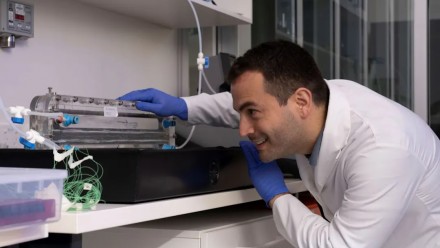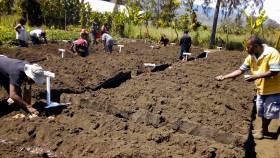ANU desalination breakthrough to bolster global water security as planet warms
A simpler and more cost-efficient method for removing salt from seawater using heat, developed by scientists from The Australian National University (ANU), could address unprecedented global water shortages.
By 2025, 1.8 billion people will likely face what the Food and Agriculture Organization (FAO) calls “absolute water scarcity.”
To help combat the water crisis, ANU researchers have developed the world’s first thermal desalination method, where water remains in the liquid phase throughout the entire process.
The research, published in Nature Communications, demonstrates how the power-saving method is triggered not by electricity, but by moderate heat generated directly from sunlight, or waste heat from machines like air conditioners or industrial processes.
Lead Chief Investigator, Dr Juan Felipe Torres, a world-leading mechanical and aerospace engineer who first proposed the concept of thermodiffusive desalination, said the phenomenon behind this technology, called ‘thermodiffusion’ or ‘the Soret effect’, was discovered in the 19th century yet has remained underutilised.
“We’re going back to the thermal desalination method but applying a principle that has never been used before, where the driving force and energy behind the process is heat,” he said.
“Thermodiffusion was a phenomenon first reported in detail in the 1850s by Swiss scientist Charles Soret, who experimented with a 30-centimeter water tube where one part of the water was colder and the other hotter.
“He discovered that the salt ions move slowly to the cold side.”
To test whether this effect can be used for water desalination, the researchers pushed seawater through a narrow channel heated from above to 60 degrees and cooled from below to 20 degrees.
“Diffusion was taking 53 days to reach a steady state with a 30-centimeter tube which is much too long for our purposes and isn’t scalable,” Dr Torres said.
“Our mission became to find a way to fast-track the diffusion process.”
The ANU researchers found that adjusting the conditions for separation could significantly increase the speed of the diffusion process to just a couple of minutes.
“The key was reducing the channel height from 30 centimetres to one millimetre and adding multiple channels,” Dr Torres said.
ANU PhD student and first author, Shuqi Xu, said once the salt had migrated to the cooler water, the device reprocessed the warmer, purified water through the channel while the cooler, saltier water was removed.
“Each time the water passed through the channel, its salinity was reduced by three per cent,” Ms Xu said.
“Our research shows that after repeated cycles, seawater salinity can be reduced from 30,000 parts per million to less than 500.”
According to the ANU researchers, current desalination technologies – where salt is filtered through a membrane – require large amounts of electric power and expensive materials that need to be serviced and maintained.
“Eighty per cent of the world’s desalination methods use reverse osmosis, which adds complexity and is costly to run,” Dr Torres said.
“If we continue fine-tuning the current technology without changing the fundamentals, it might not be enough.
“A paradigm shift is essential to sustain human life over the next century.”
With further testing, the researchers hope to produce the first commercial unit within eight years.
The research has received funding from the Department of Foreign Affairs and Trade and Australia’s Science and Technology for Climate Partnership (SciTech4Climate) program. The project also received support from the ANU Institute for Climate, Energy and Disaster Solutions (ICEDS).
“The project has deployed a commercial state-of-the-art solar-driven desalination unit to Tonga, to pilot its application for agriculture and drought mitigation strategies,” Dr Mona Mahani, from ICEDS, said.
This story originally published by the ANU Reporter.











